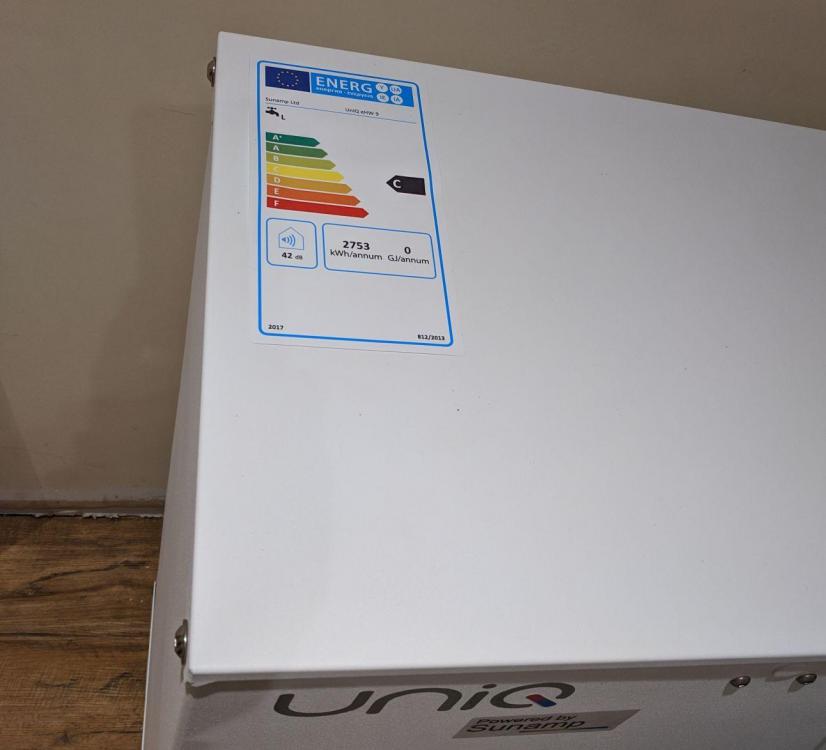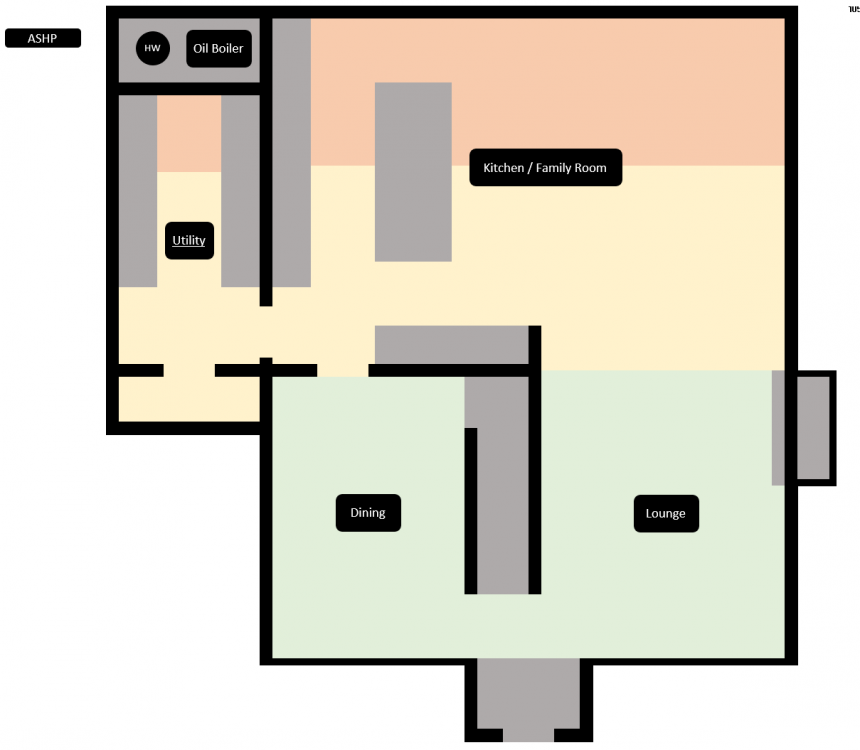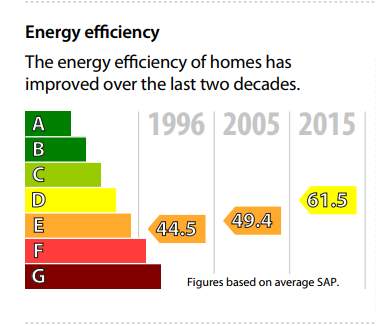Search the Community
Showing results for tags 'epc'.
-
Maybe I’m missing understanding these EPC calculations are doing but they currently don’t make sense to me and I wonder if they make more sense to others? I’ve just looked at a EPC for a neighbours flat that just went on the market this week and the calculation goes like this:- Page 1 Dwelling type: Mid-floor flat Date of assessment: 20 February 2023 Total floor area: 95 m2 Primary Energy Indicator: 234 kWh/m2/year Page 3 Space heating (kWh per year) 12,707 Water heating (kWh per year) 1,992 Page 3 seems wrong to me, for Space heating should it not be Total floor area: 95 m2 * Primary Energy Indicator: 234 kWh/m2/year to = 22,230 kWh per year? Gas boiler in flat is probably 80% efficient, so per year for combined water and space heating one would be using approc. 29,066 per year. Usual energy estimates are for 3 years so that would be 87,200 kWh and current gas prices per kWh are 10p so that would be £8,719 for space and water heating not including general electricity use but the estimated energy cost for 3 years given on the EPC is £5,934, seems well short to me. So the £ estimate being off I’m not to surprised at but the simple calculation from floor space to yearly space heating should be bang on at 22,230 kWh per year and not 12,707 kWh? Also when I bought my apartment which is very similar to the flat above, my EPC stated the Primary Energy Indicator was to be: 132 kWh/m2/year, so that’s a big difference, turns out 234 kWh/m2/year is fairly accurate as I did use 22,000 kWh in my first year of staying here. I’ve managed to get that down to around 16,000 kWh with new boiler and single room MVHR but still far in excess of the promised 12,936 kWh on the EPC which came on the home report when I purchased the appartment. Best wishes, DD 😎
-
Most of us calculate Design EPC numbers using the free FSAP software from Stroma. This is a thread for help and questions, since I may be about to ask a few. Ferdinand
- 47 replies
-
So my new PCM58 has arrived (see for why I have a new one): And the new one has an energy efficiency sticker on it: Show only grade C - which is well below my expectation. Anyone know why it is given such a poor mark, I thought one of the key selling points was it was a super highly insulated way of storing heat.
- 186 replies
-
- 3
-

-
- sunamp
- energy efficiency
-
(and 1 more)
Tagged with:
-
I'm in the early stages of the refurb of a 1917 property in Kent. The rough downstairs floorplan is below - The floor is a real hotchpotch of suspended floor (45% - Green), Previous extension concrete floor ( 35% - Yellow) and New proposed extension (Orange 20%). The current EPC is a horrible 23 and we're looking at using a combination of internal and external insulation to improve this. This may be an opportunity to seal the house (replacing floorboards?) Trying to bring all the potentially different technologies and solutions together is a challenge and every choice seems to lead to a particular specialist supplier that may have a particular axe to grind/product to sell. There is a wealth of knowledge and experience on this forum that I am very glad that I have found. Regards Tet
-
- ufh
- solid walls
-
(and 2 more)
Tagged with:
-
Ideally this is one for a tame EPC Assessor! Do we have any idea how EPCs will adjust under the new values? Has anyone rerun their numbers? Cheer Ferdinand
-
I have seen comment on BH that an EPC of 100 is nominally a Zero Energy house. Can anyone give me a source I can reference for this? (Needed for blog post). Cheers Ferdinand
-
I am hoping someone has done this, I am currently looking at doing a loft conversion in a rented property. One aspect is that I am likely to need an EPC grade of C by 2030 to be able to let it legally at that point. I have done most of the low hanging fruit already .. 50mm celotex IWI where needed, 250mm loft ins., 2G and so on. there is a boiler swap to condensing and HR to be done at some stage, but the EPC is currently D58, which is quite poor given that energy bills only run at -60 per month, and I do not think that a boiler alone will give me 12 more points. So I need to take some care. If I do a well insulated loft conversion .. say to add 25sqm to the loft area in addition to the existing 85sqm area, does the per area algorithm for an EPC mean that in practise I get a nice boost for the extra area with only a marginal increase in energy use? (I am in a position to do a cost-effective conversion for various reasons.) Cheers Fedinand
-
Still considering my heating options (see here) and looking at the RHI on an ASHP, I see that I need to get a new EPC as the other one I have is more than 2yrs old and the rating at the end of the highly useful report? tells me it an ' E' (46). So I would need to get a new assessment done before I have the ASHP fitted (should I indeed go that route). If I do decide to go down the ASHP route, then I want to get that installed at the same time as all the rest of the plumbing systems and not have the mess/extra labour visits/costs to fit an ASHP after the house is 'complete'. As of today, I have a shell of a house still. Would they still be able to undertake an assessment? Windows and doors in, so that'll be a tick for the 'doubled glazed' box on the assessor's sheet and I get a gold star for the panels on the roof. But I have no heating, the loft is bare (no insulation), old crappy CWI is mostly gone, so my efficiency rating would probably be closer to an F than an D! In terms of the RHI, that appears to be based on the total heat demand - but how is that assessed if I have no heating installed yet? Do I just inform the assessor that I will be fitting UVC/ST/Sunamp/re-instating the old oil boiler?
-
Insulating to Min Building Regs
Ian posted a topic in Energy Efficient & Sustainable Design Concepts
I know that most people here are building homes that will far exceed the minimum standards required by Part L of the Building Regulations (Part L = conservation of fuel & power) I finished my own build about a year ago - it's a small 2 bed holiday home on a remote site in N Wales and I decided to build it to just meet the minimum standards allowable in Part L and I thought it may be useful to give those of you who are exceeding Part L requirements an example of minimum compliance for comparison purposes. It's a single storey timber frame and timber clad bungalow with a net internal area of 71 m2 and an internal heated volume of 234 m3 (we've exposed the pitch of the roof internally). It's a rectangular shape on plan as it's built along the contour of a 1:8 sloping site. (Small rectangular bungalows are about the worst shape for energy efficiency). It's heated by bulk LPG and a combi boiler. No PV or other renewables. Naturally ventilated with no MVHR. These are my SAP figures: EPC C71 [Edit to add EI Rating of B81] Averaged (area weighted) 'U' values for walls, floor and roof of 0.15 Actual 'U' values are: floor 0.1 (we have a ground bearing conc slab with Hive app controlled underfloor heating and 300mm of EPS under the concrete) walls: 0.21 (minimum allowed in Welsh regs). Roof: 0.13 Windows 3G 0.8 Air test actual figure of 3.7 m3/(h.m2) (no special tapes or air tightness layer) Energy demand figures from the SAP calculation: Heating demand 3400 kWh (this equals 47.9 kWh/sqM of internal area) Hot water: 2290 kWh Electric for pumps and fans: 120 kWh Electric for lighting: 314 kWh (all LED) Primary Energy Demand: 106.1 kWh/sqM/year [Edit to add: CO2 emissions: 1,596 kg/yr CO2 emissions: 22.49 kg/m2] The house is warm and draught free. The things I like most about it apart from the location and spectacular views are the open plan layout with tall 'cathedral' ceilings, the u/floor heating and the 3G windows. I'd be very interested in seeing comparative figures for your own builds. Ian- 26 replies
-
- 2
-

-
A quick EPC question to which I cannot find an answer. What would be an EPC value for a typical "building regs minimum" newbuild property? I did however find numbers for how EPC values have changed over the last 20 years. Right direction, more still to do. Source: https://www.gov.uk/government/uploads/system/uploads/attachment_data/file/627688/Potential_stock_improvements_Report_2015-16.pdf
-
This is mainly for @Crofter, depending on how Wee the new Hoose actually is - put here in case anyone else finds it. In England, detached buildings under 50sqm are exempt from having an EPC done. https://www.gov.uk/energy-performance-certificate-commercial-property/exemptions If it is also so in Scotland, that could save you a little money and hassle - if you are under 50sqm and so minded. I have one under 50sqm - the detached 48sqm cottage my dad was born in, which is now a rental. I have the EPC number up to 51, and the half of it which has been drylined since about 1984 (25mm eps) was ignored by the EPC man, but that is about the limit of what is achievable practically. When push comes to shove in 2026 I will rely on the exemption rather than make a "too expensive to upgrade it" argument. Ferdinand







